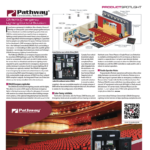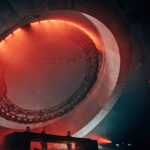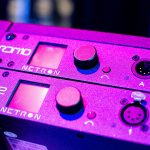Today, we’re not going to look at the latest in whiz-bang technology or the coolest LED fixture on the market, but rather at the technological building blocks of a good show — networking and data distribution hardware from TMB. As our show networks get larger and more complicated, the need for sophisticated and reliable networking technology grows ever more important.

ProPlex EZ-Lan Unity 20
The ProPlex EZ-LAN Unity 20 is a ruggedized networking switch with some features intended specifically for entertainment networking. Physically, the unit is a rack-mounted enclosure with 16 Neutrik EtherCON connectors (which will also accept bare RJ-45 connectors) along the front, and four trunk connectors on the rear, two EtherCON and two optical. Each block of four is intended to be used together, and the user can separate each block into one of nine private virtual LANs (VLAN). Capable of gigabit speeds, this unit is designed to help as the sheer amount of data that today’s productions need to transmit keeps rising.
This is where things get interesting; there’s a lot of utility in having separately-assignable VLANs. One could set every block to be the same VLAN and use the EZ-LAN as a basic sixteen-port switch. You could set them all separately and use it as four switches in one, or any combination in between. The practical applications for this are myriad — for instance, instead of having two different switches at front of house for a proprietary console protocol and Art-Net, the user could have one device carry both.
The trunk lines on the back extend the usefulness of this system even further. With these, two or more EZ-LAN devices can be networked together instantly and without worrying about settings, and the data transmitted on one VLAN can be accessed by setting the ports on the front to that VLAN on the second EZ-LAN. This makes getting data to many locations simple. Consider a production needing separate networks for lighting, video, sound, media server, Internet, and a utility line for whatever else at each of those locations. The user could create seven separate networks for each department and have a EZ-LAN at each location, with only one cable necessary between each unit. If one location needed more outputs, the user would simply set any number of the four blocks to the same VLAN. Different network topologies can be employed for specific circumstances; such as ring topology for additional redundancy. There is also an additional group for the front connectors which appears as a “.” or period on the display, which sets that block to the “trunk line” group, duplicating the function of the rear ports.
The two trunk lines on the rear can be also used concurrently in order to provide additional throughput and add redundancy to the system, so that if one line goes down the other can take over. All electronics inside are also shock-isolated to help prevent the bumps and shakes of the road from causing issues, and the unit weighs 10.8 pounds (4.9 kilograms) and is 19 by 3.5 by 12 inches (WxHxD). Power is provided by Neutrik PowerCON in and throughs, and auto-ranges input voltage from 100-240V.
ProPlex EZ-Lan Unity 20
- Size: 9” x 3.5” x 12”
- Weight: 10.8 lbs.
- Power: 100-240V, 50/60Hz
- MSRP: $6,665
- More Info: www.tmb.com

ProPlex IQ Two 1616
The IQ Two 1616 is a gigabit lighting network node that accepts both Art-Net and sACN over Ethernet and outputs DMX, while offering simple configuration and setup. This unit is similar in appearance and construction to the other products in the TMB networking range, with a blue steel chassis constituting a four space rack-mount enclosure and vibration-isolated electronics. On the front face of the unit is an array of 16 5-pin DMX ports along with a full-color LCD touchscreen which displays the IP address, protocol being used, and other useful networking information, including port assignments to easily identify which port is which. This front screen is also where all configuration happens on the device, like setting the IP and subnet, protocol being used, and other options. Other displays on this screen show network load from 0-100 percent, and a simple universe visualizer that displays channel levels. On the rear is a single Neutrik EtherCON RJ45 for data input.
The 1616 “listens” for only one protocol at a time; it cannot simultaneously decode both sACN and Art-Net. TMB says an upcoming software release will add the ability to set the protocol on a port-by-port basis. In a simple usage case scenario, once connected to a lighting network, the device automatically detects the incoming data and outputs the information to any or all of the 16 ports on the front of the unit — each separate port can be configured to output any universe. However, although it ships in this simple networking mode, the user can do sophisticated filtering via subnets if desired. A second usage scenario might see the front DMX ports configured as inputs (with turnarounds), accepting incoming DMX data and converting it back into Art-Net or sACN for use on another network device. TMB rates the processor and gigabit processing inside the 1616 as capable of processing more than 75 universes of Art-Net data at a time, with performance improving significantly with a sACN network due to the vastly improved efficiency of that protocol.
The unit can also merge Art-Net or streaming ACN from multiple sources in situations with multiple consoles. There are four options to cover the user’s needs: highest takes precedence (HTP), sACN priority (determined at the console), Easy Merge and onboard port priority. Highest take precedence gives control to the highest value on a shared channel and is industry-standard. Easy Merge allows two or more consoles to take control based on which has the highest value on the 512th channel of a given universe. This should be especially useful in festival or corporate situations where a guest console needs access to the rig without the hassle of physically un-patching and re-patching. Port priority assigns priority on a port-by-port basis, so that the user can specify which ports take over should another lose data.
The 1616 is fully RDM-compliant, and features an option to prevent RDM from being passed for lights that glitch when seeing RDM information. On the management side, the unit includes ProPlex IQ Manager, a Windows software suite for the IQ series. IQ Manager provides access to all the functions that can be changed on the front interface of the device and functions over a network for remote management. Users or rental shops can also batch program and manage their devices all at once with this software. It also includes a suite of RDM management tools, including all the functions of a console to re-address, change modes, and pull reports from the fixtures. With RDM support just now starting to be fully implemented on console software, this is a great way to have fast access to a rig of RDM-enabled fixtures. TMB has also implemented a web interface on the 1616 for remote management from a web browser.
The unit weighs 10.8 pounds (4.9 kilograms) and is 19 by 3.5 by 8 inches (WxHxD). Power is provided by an included PowerCON cable and auto-ranges input voltage from 100-240V.
The IQ Two fills a unique niche in the market — a need for a road-worthy and rugged sACN and Art-Net networking device with several modes useful for both touring acts, festivals, and installations.
ProPlex IQ Two 1616
- Size: 9” x 3.5” x 12”
- Weight: 10.8 lbs.
- Power: 100-240V, 50/60Hz
- MSRP: $4,939
- More Info: www.tmb.com
An earlier version of this posting, and the printed version of this story (PLSN, Sept. 2016, page 78, bottom) included an incorrect product image, PLSN regrets the error.)


